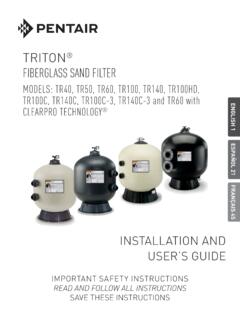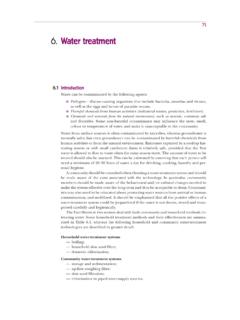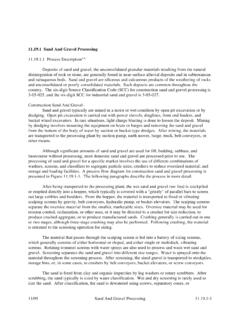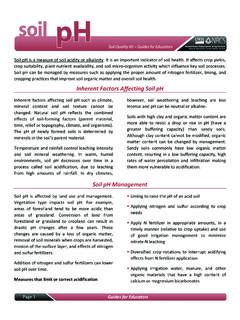Transcription of Side Stream Filtration for Cooling Towers
1 Side Stream Filtration for Cooling TowersPrepared for the Department of Energy Federal Energy Management Program By Pacific Northwest National Laboratory X. Duan, Williamson, McMordie Stoughton and BoydOctober 2012 FEDERAL ENERGY MANAGEMENT PROGRAM i Contact Will Lintner, PE Federal Energy Management Program Department of Energy 1000 Independence Ave. SW Washington, DC 20585-0121 Phone: ( 202) 586-3120 E-mail: Cover photo: Cooling Towers . Photo from Pacific Northwest National Laboratory ii Acknowledgements The authors of the report would like to thank the following individuals that provided support to the production of the technology evaluation: Elisabeth Giever Rose Zanders Jim Cabe Matt Wilburn Shannon Colson iii Abbreviations and Acronyms ASHRAE American Society of Heating, Refrigerating, and Air Conditioning Engineers BLCC Building Life Cycle Cost FEMP Federal Energy Management Program gpm gallons per minute kW kWh kilowatt kilowatt hour LCC L life-cycle cost liter mm millimeter ORNL Oak Ridge National Laboratory ROI return on investment SNS Spallation Neutron Source TSS total suspended solid iv Contents Executive Summary.
2 Vii 1 Technology Review and Evaluation .. 1 Background ..1 Technology Characterization ..3 Technology Applications ..5 2 Side Stream Filtration System Options .. 7 Centrifugal Separators ..7 Automatic Screen Plastic Disc Filters ..9 sand Filters ..10 Pressure sand Filters ..11 High Efficiency sand Filters ..12 3 System Economics .. 13 4 Evaluate Field Application of Technologies .. 15 5 System Implementation Considerations .. 16 6 References .. 19 v List of Figures Figure Cooling Tower Primary Treatment Concerns.. 2 Figure Cooling Tower with Side Stream Filtration 3 Figure Centrifugal Separator Schematic.. 8 Figure Automatic Screen filter Schematic.. 9 Figure Plastic Disc Filters.. 10 Figure Pressure sand filter Schematic.. 11 Figure High Efficiency sand filter Schematic.. 12 vi List of Tables Table Side Stream Filtration System Characteristics .. vii Table Relative Size of Common Cooling Water Contaminants (McDonald 2009).
3 4 Table Side Stream Filtration System Characteristics.. 7 Table Life-Cycle Analysis for Gravity sand Filtration Systems.* .. 14 Table ORNL Particle Distribution Analysis.. 15 vii Executive Summary This technology evaluation assesses side Stream Filtration options for Cooling Towers , with an objective to assess key attributes that optimize energy and water savings along with providing information on specific technology and implementation options. This information can be used to assist Federal sites to determine which options may be most appropriate for their applications. This evaluation provides an overview of the characterization of side Stream Filtration technology, describes typical applications, and details specific types of Filtration technology. Cooling Towers are an integral component of many Cooling systems that provide comfort or process Cooling . Cooling tower systems operation is most efficient when their heat transfer surfaces are clean.
4 However, due to variations in the water source and their operating in an open environment, Cooling Towers are subject to four major water treatment concerns: corrosion, scaling, fouling and microbiological activity. These factors can significantly reduce the efficiency of the Cooling Towers . Side Stream Filtration systems can be a cost effective method to address these water concerns through filtering suspended solids out of the Cooling water. Side Stream Filtration systems continuously filter a portion of the Cooling water to remove suspended solids, organics, and silt particles, reducing the likelihood of fouling and biological growth, which in turn helps to control other issues in the system such as scaling and corrosion. This results in both water and energy efficiency gains due to a reduction in the amount of water discharged from the Cooling system and a decrease of scale formation on the heat transfer surfaces.
5 The filter types examined in the technology evaluation are centrifugal separators, automatic screen filters, plastic disc filters, and sand filters. An overview of their main characteristics is summarized in Table and more detailed information on each system type is presented in the main body of the report. Table Side Stream Filtration System Characteristics. filter Type Particle Removal Level Basic Filtering Mechanism Applications Notes Centrifugal Separators 40-75 microns, fine to coarse inorganics with a specific gravity ( ) or greater High velocity water is fed in a circular pattern that moves heavier particles down and out of the system Best for removal of large, heavy particles Minimal maintenance is required Automatic Screen filter Down to 10 microns Water moves through a rigid screen, where large particles are trapped and sucked out of the system Best for systems that cannot be interrupted such as industrial processes and hospitals Self cleaning mechanism allows for no interruption in operation Plastic Disc filter Down to 10 microns Grooved, stacked plates trap particles as water moves through the discs Appropriate where removal of both solids and organics are required Self cleaning mechanism is automatic and requires little down time of the system sand Filters Down to 10 microns for pressure sand filters.
6 Down to microns for high efficiency sand filters Layers of granulated sand , trap particles as water moves through the sand layers Best for applications that require the removal of fine and low density particles Supplemental chlorine may be needed because sand filters can promote biological growth viii A life-cycle cost analysis was performed on a hypothetical example of a pressure sand filter side Stream Filtration system as part of the technology evaluation. The system characteristics were based on a typical system for a 400 ton chiller with a total installation cost of $45,000 (see Section 3 on System Economics for more details on the example system). The results of the life-cycle cost analysis shows an annual cost savings of $8,800, 8 year simple pay back, and a savings to investment ratio of When considering a side Stream Filtration system, there are several key parameters that are important to weigh including the level of particle removal, Filtration sizing, installation methods, economic analysis, and savings potential.
7 Careful examination of these features will help to properly specify the side Stream Filtration system for the appropriate application. 1 1 Technology Review and Evaluation This technology evaluation was performed by Pacific Northwest National Laboratory on behalf of the Federal Energy Management Program (FEMP). The technology evaluation assesses side Stream Filtration for Cooling Towers . The evaluation provides a characterization of side Stream Filtration technology, describes typical applications, and details specific types of Filtration technology. System economics are also discussed, providing an example project with life-cycle cost analysis results to show the potential savings of a typical application. A Federal case study at Oak Ridge National Laboratory (ORNL) is also provided to showcase a success story of a side Stream Filtration application. The evaluation s overall objective is to provide information on key impacts related to energy, water, and cost savings of side Stream Filtration as well as key attributes on specific technology options and component specifications so that Federal energy and facility managers can make informed decisions on which options may be most appropriate for their site.
8 Background Cooling Towers are an integral component of many Cooling systems that provide comfort or process Cooling . They are commonly used in industrial applications and in large commercial buildings to release waste heat extracted from a process or building system through evaporation of water. They receive the heated water, and evaporate a portion of the water to cool the remaining water so that it can re-used to again extract heat from the Cooling system. Cooling tower systems operation is most efficient when their heat transfer surfaces are clean. However, these are dynamic systems, due to variations in the water source and their operating in the open environment. Surface water sources such as lakes, rivers, and streams have seasonal variations in water quality and can carry high levels of suspended silt and debris. Groundwater sources don t have the seasonal variations, but can have high levels of dissolved minerals depending on the geology of the region.
9 Since Cooling Towers operate outside they are susceptible to dirt and debris carried by the wind. Birds and insects like to live in and around Cooling Towers due to the warm, wet environment. The combination of process and environmental factors can contribute to four primary treatment concerns encountered in most open-recirculating Cooling systems: corrosion, scaling, fouling, and microbiological activity. As shown in Figure , these treatment concerns are inter-related such that reducing one can have an impact on the severity of the other three. Corrosion: Corrosion is an electrochemical or chemical process that may lead to the premature failure of system metallurgy. The process of corrosion can be intensified by elevated levels of dissolved mineral content in the water and the presence of oxygen, both of which are typical of most Cooling tower systems. 2 Scaling: Scaling is the precipitation of dissolved mineral components that have become saturated in solution, which can lower efficiency of the system.
10 Factors that contribute to scaling tendencies include water quality, pH, and temperature. Scale formation inhibits heat exchangers because of the insulating properties of scale. Scale buildup will make the entire system work harder to meet the Cooling demand. Fouling: Fouling occurs when suspended particles or biologic growth forms an insulating film on heat transfer surfaces. Common foulants include organic matter, process oils, and silt, which can also lower system performance. Factors that cause fouling include corrosion and process leaks. Much like scale, fouling deposits create an insulating barrier on the heat exchanger surfaces that can significantly affect the energy performance of the Cooling system. Microbiological Activity: Microbiological activity refers to microorganisms that live and grow in the Cooling system that can contribute to fouling and corrosion. Cooling Towers are a perfect environment for biological activity due to the warm, moist environment.

















